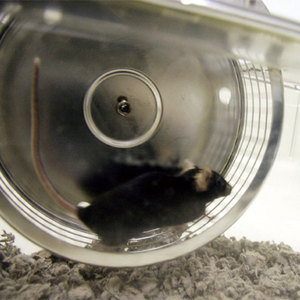Jul. 5, 2006 Research Highlight Medicine / Disease
Moody mice and humans not necessarily poles apart
Transgenic ‘moody’ mice provide model for testing drugs to treat bipolar disorder and investigate its causes in humans
 Figure 1: The researchers analysed wheel-running activity of their transgenic mice to determine alterations in behavior.
Figure 1: The researchers analysed wheel-running activity of their transgenic mice to determine alterations in behavior.
Brain researchers from RIKEN have developed a useful mouse model for the debilitating human mental condition of bipolar disorder. In doing so, they have strengthened a proposed link between bipolar disorder and disruption of the function of mitochondria—the energy production centres—in nerve cells in the brain.
The work should lead to better targeted research to unravel the genetic and molecular details of what leads to bipolar disorder, and potentially to the development of future therapies.
Earlier research has shown there is a strong inherited or genetic component of bipolar disorder. Recent studies have demonstrated that bipolar disorder is associated with altered mitochondrial function in the brain, and that patients with mitochondrial diseases also sometimes have mood disorders. Taken together, these pieces of evidence suggest that genetic mutations which disrupt the workings of the mitochondria in the brain may be responsible for mood disorders.
So, researchers from the RIKEN Brain Science Institute in Wako focused their studies on a human mitochondrial disease, chronic progressive external ophthalmoplegia, which is both caused by genetic mutation and linked to mood disorders. The researchers were able to generate transgenic mice with a similar condition. Their research is reported in Molecular Psychiatry 1.
It is difficult to determine moods in non-human animals, and to compare them with their human equivalents. The research team therefore decided to judge whether the genetic changes in their transgenic mice led to a state like a human mood disorder on the basis of three criteria—similarities in behavior, a common mechanism which explains the disorder in both mouse and human, and the same reactions to treatment with the same drugs.
The researchers, in collaboration with colleagues from the Nagoya University Graduate School of Medicine, found their transgenic mice not only had similar genetic mutations in the nerve cells of the forebrain as humans with bipolar disorder, but also showed characteristic altered behavior (Fig. 1). In addition, the transgenic mice reacted to antidepressants and to mood stabilizing drugs in a similar way to humans with bipolar disorder.
The researchers now aim to use their model to identify the details of the molecular pathway by which the mutation has its impact, says team leader, Tadafumi Kato. “We also want to use the mice to evaluate candidate drugs for therapy, and we hope to identify the neural circuit directly linked to bipolar disorder.”
References
- 1. Kasahara, T., Kubota, M., Miyauchi, T., Noda, Y., Mouri, A., Nabeshima, T. & Kato, T. Mice with neuron-specific accumulation of mitochondrial DNA mutations show mood disorder-like phenotypes. Molecular Psychiatry advance online publication, 18 April 2006. doi: 10.1038/sj.mp.4001824
